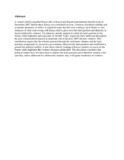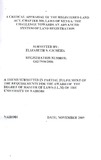Location
Our Vision is to be a world-class university committed to scholarly excellence.
Our Mission is to provide quality university education and training and to embody the aspirations of the Kenyan people and the global community through creation, preservation, integration, transmission and utilization of knowledge.
Core Values
In order to realize the above vision and mission, certain shared values shall be nurtured. There is great need for the University to be guided by the right values derived from the virtues and moral standards of the Kenyan and wider society.
Core Functions
Teaching and Learning: The university offers innovative , relevant and market driven academic programmes , both at undergraduate and postgraduate levels with inbuilt quality control systems the university also provides an environment and policy framework for undertaking high quality and relevant research
Members:
Resources
Displaying 146 - 150 of 298Land-Use Change and Livestock Production Challenges in an Integrated System: The Masai-Mara Ecosystem, Kenya
Participatory rural appraisal techniques and a survey of 100 households were used to evaluate livestock production, and pastoral development of the Maasai in Mara. It was observed that patterns of land-use have principally changed from nomadic pastoralism to sedentary pastoralism, agropastoralism, and, in some cases, pure cultivation. These trends have adversely affected livestock production and the productive capacity of the Mara ecosystem.
Web-Phone land information and billing System: Getting the Registry on your Mobile Phone
Survey of Kenya is the country's institution charged with the
responsibility of collecting, checking, storing and disseminating Land
parcel related records.
Of late efforts have been made to digitize these records and form a
database. However the majority of the records are in paper form.
Dissemination of this data, done through a search, is still manual. The
public fill a search form and pay a small fee, and the records are
reproduced to them in form of a filled and dully signed form or map or
Use of GIS to manage community-based land transactions: Case Study: Kirinyaga Central District
The elements of Land Administration in Kenya are very fragmented and independently operated
within the Ministry of Lands. During institutional reform there is opportunity to provide a much
more integrated Land Administration service to the citizens, especially at the district level
through the formation of ‘one-stop-shops’, through the integration and rationalization of the
existing land administration and land rights delivery systems.
This project report highlights the benefits offered through the application of GIS in management
The legacy of the white highlands: Land rights, ethnicity and the post-2007 election violence in Kenya
A violent conflict engulfed Kenya after a flawed and disputed presidential election result in December 2007. Before then, Kenya was considered an icon, a bastion of political stability and economic prosperity in Africa. It surprised many that this icon would go up in flames so fast. Analyses of what went wrong with Kenya tend to gloss over the land question and ethnicity as factors behind the violence.





